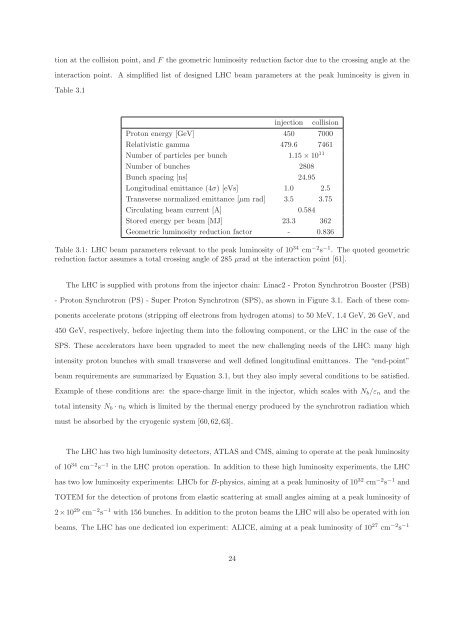CERN-THESIS-2012-153 26/07/2012 - CERN Document Server
CERN-THESIS-2012-153 26/07/2012 - CERN Document Server
CERN-THESIS-2012-153 26/07/2012 - CERN Document Server
Create successful ePaper yourself
Turn your PDF publications into a flip-book with our unique Google optimized e-Paper software.
tion at the collision point, and F the geometric luminosity reduction factor due to the crossing angle at the<br />
interaction point. A simplified list of designed LHC beam parameters at the peak luminosity is given in<br />
Table 3.1<br />
injection collision<br />
Proton energy [GeV] 450 7000<br />
Relativistic gamma 479.6 7461<br />
Number of particles per bunch 1.15 × 10 11<br />
Number of bunches 2808<br />
Bunch spacing [ns] 24.95<br />
Longitudinal emittance (4σ) [eVs] 1.0 2.5<br />
Transverse normalized emittance [µm rad] 3.5 3.75<br />
Circulating beam current [A] 0.584<br />
Stored energy per beam [MJ] 23.3 362<br />
Geometric luminosity reduction factor - 0.836<br />
Table 3.1: LHC beam parameters relevant to the peak luminosity of 10 34 cm −2 s −1 . The quoted geometric<br />
reduction factor assumes a total crossing angle of 285 µrad at the interaction point [61].<br />
The LHC is supplied with protons from the injector chain: Linac2 - Proton Synchrotron Booster (PSB)<br />
- Proton Synchrotron (PS) - Super Proton Synchrotron (SPS), as shown in Figure 3.1. Each of these com-<br />
ponents accelerate protons (stripping off electrons from hydrogen atoms) to 50 MeV, 1.4 GeV, <strong>26</strong> GeV, and<br />
450 GeV, respectively, before injecting them into the following component, or the LHC in the case of the<br />
SPS. These accelerators have been upgraded to meet the new challenging needs of the LHC: many high<br />
intensity proton bunches with small transverse and well defined longitudinal emittances. The “end-point”<br />
beam requirements are summarized by Equation 3.1, but they also imply several conditions to be satisfied.<br />
Example of these conditions are: the space-charge limit in the injector, which scales with Nb/εn and the<br />
total intensity Nb · nb which is limited by the thermal energy produced by the synchrotron radiation which<br />
must be absorbed by the cryogenic system [60,62,63].<br />
The LHC has two high luminosity detectors, ATLAS and CMS, aiming to operate at the peak luminosity<br />
of 10 34 cm −2 s −1 in the LHC proton operation. In addition to these high luminosity experiments, the LHC<br />
has two low luminosity experiments: LHCb for B-physics, aiming at a peak luminosity of 10 32 cm −2 s −1 and<br />
TOTEM for the detection of protons from elastic scattering at small angles aiming at a peak luminosity of<br />
2×10 29 cm −2 s −1 with 156 bunches. In addition to the proton beams the LHC will also be operated with ion<br />
beams. The LHC has one dedicated ion experiment: ALICE, aiming at a peak luminosity of 10 27 cm −2 s −1<br />
24















